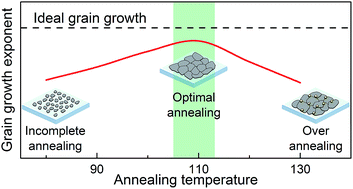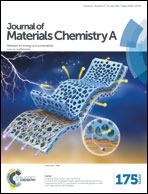Crystallisation dynamics in wide-bandgap perovskite films†
Abstract
Organic–inorganic metal halide perovskite materials have evolved as highly efficient photovoltaic materials with a controllable range of bandgaps. This trait offers exciting prospects for the application of perovskites as wide-bandgap thin-film top solar cells in tandem architectures with crystalline silicon bottom solar cells. In this work, we present a systematic material study on spin-coated methylammonium lead trihalide (CH3NH3Pb(I0.6Br0.4)3) that has a band gap of 1.77 eV, optimal for tandem architectures with crystalline silicon. Using a combination of X-ray diffraction, time-resolved photoluminescence, and scanning electron microscopy techniques, we determine the strong impact of annealing temperature and duration on perovskite film crystallinity, carrier lifetime, and average grain size. We further demonstrate a clear correlation between solar cell performance and crystallisation dynamics in the perovskite films. With optimised crystallisation of the perovskite films, our solar cells exhibit peak power conversion efficiency of 10.6% that stabilises at 9.0% after 10 minutes of maximum power point tracking. Finally, the activation energy for grain boundary mobility, and grain growth exponents are determined via quantitative analysis of grain growth kinetics, and hence, perovskite film quality.



 Please wait while we load your content...
Please wait while we load your content...